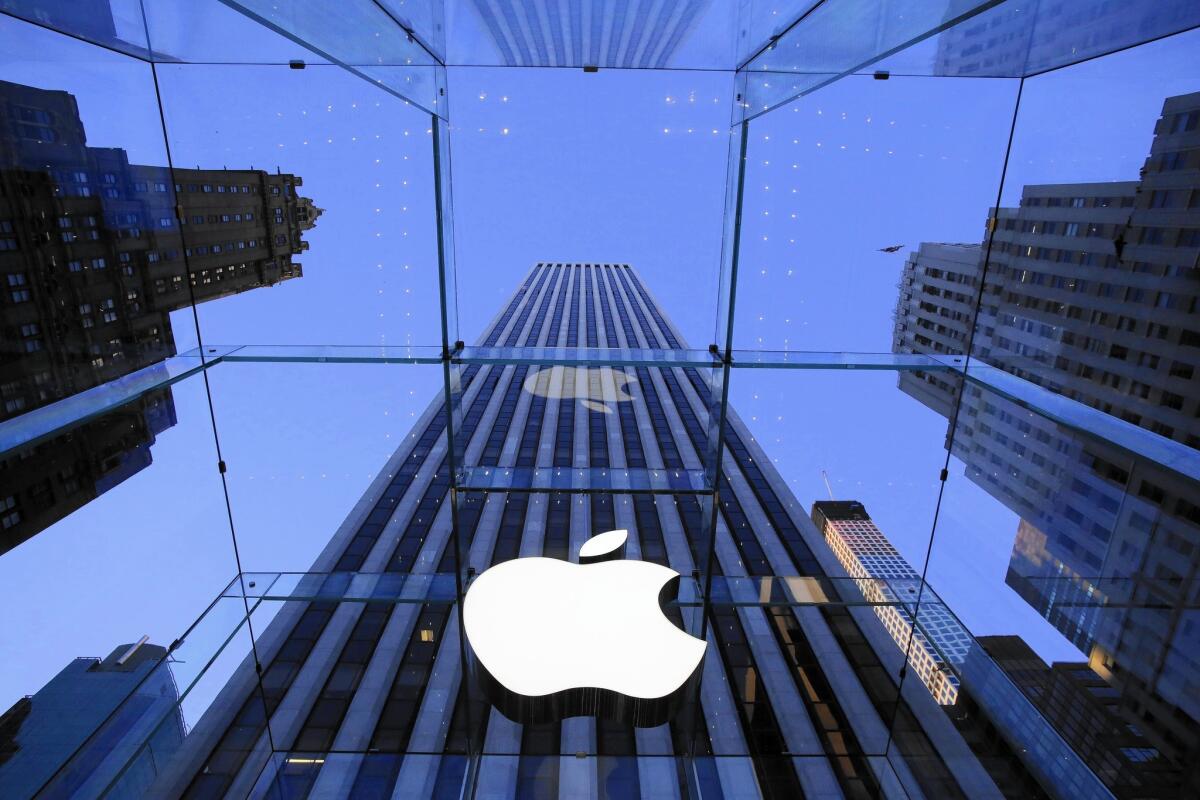Apple Inc. finally joins ranks of the Dow’s elite 30 stocks

REPORTING FROM NEW YORK — Apple Inc., the world’s most valuable company, finally will take its place as a member of the elite 30 stocks in the Dow Jones industrial average, starting after trading closes March 18.
The Cupertino, Calif., powerhouse will replace telecommunications firm AT&T Inc. on the roster, S&P Dow Jones Indices said Friday.
The rise of Apple to the 119-year-old Dow index, whose components change only infrequently, was perhaps as inevitable as such a selection can be.
After a breathtaking rise since the mid-2000s, Apple has established itself as perhaps the country’s most prominent corporation of any kind, a perception cemented by its becoming the most valuable public company ever in 2012.
Indeed, its inclusion among the country’s blue-chip companies was delayed only by the fact that its shares were so expensive they would have distorted the index. Apple’s 7-to-1 stock split brought its price closer to the median price of the Dow, allowing the technology giant to bump out AT&T, which is still formidable but much lower in value than it once was.
The replacement of AT&T with Apple is emblematic of how the Dow has managed to adapt to changes in markets and the economy, said Richard E. Sylla, a historian of financial institutions and markets at New York University’s Stern School of Business.
“AT&T, which was in the Dow for much of the 20th century, was how people used to make phone calls,” he said. “Now Apple is the way people make phone calls.”
For the Dow, Apple’s inclusion helps cement the rise of technology as a foundational component of the index, a process that began in 1999 when Microsoft Corp. and Intel Corp. joined the index. It marked the first time that the Dow included tech stocks that also were part of the Nasdaq Composite Index.
The addition of Microsoft and Intel pushed to the wayside former industrial giants Union Carbide & Carbon Corp. and Goodyear Tire & Rubber Co.
Today, about two-thirds of the Dow’s 30 components are still manufacturing companies. Apple’s inclusion will make it the sixth Dow component classified as an information technology company.
Financial professionals prefer to rely on the broader Standard & Poor’s 500 Index, in part because the 500 companies in the index cover more of the economy.
Even so, the Dow has remained the “man in the street’s view of the market,” NYU’s Sylla said.
Indeed, the Dow’s roots to the 19th century has helped it retain a relevance, and even eminence, in the public imagination as the S&P and other indexes came to prominence and the Dow’s ownership of the index changed hands.
The index was created by Charles H. Dow, a co-founder of Dow Jones & Co., the publisher of The Wall Street Journal, as a means of tracking the performance of the industrial companies listed on the New York Stock Exchange and the broader U.S. economy.
As stock investing became more broadly popular in the 1920s, the Dow became more widely known largely because news organizations began quoting it as a shorthand way to gauge market performance.
For decades, selection of the Dow’s components was overseen by the managing editor of The Wall Street Journal. In 2010, Dow Jones sold a majority stake in its index business, and the Journal retained two spots on the five-member committee that decides any changes in the index.
Among the committee’s criteria in deciding what company to add to the index, a company must have “an excellent reputation,” demonstrate sustained growth and be “of interest to a large number of investors.”
Sylla said that adding Apple among the “bluest of the blue chips” only makes sense. “It’s just gotten so big,” he said.
More to Read
Inside the business of entertainment
The Wide Shot brings you news, analysis and insights on everything from streaming wars to production — and what it all means for the future.
You may occasionally receive promotional content from the Los Angeles Times.











